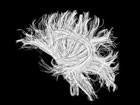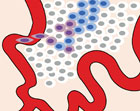 As UHN's monthly research newsletter, NRx reports on the full spectrum of leading research from UHN's five research institutes: the Princess Margaret (PM) Cancer Centre, the Toronto General Research Institute (TGRI), the Toronto Western Research Institute (TWRI), the Toronto Rehabilitation Institute (TRI) and the Techna Institute (Techna).
As UHN's monthly research newsletter, NRx reports on the full spectrum of leading research from UHN's five research institutes: the Princess Margaret (PM) Cancer Centre, the Toronto General Research Institute (TGRI), the Toronto Western Research Institute (TWRI), the Toronto Rehabilitation Institute (TRI) and the Techna Institute (Techna).
In this issue you can read about:
- A new genetic test that predicts prostate cancer recurrence
- The need for more cardiac rehabilitation options for women
- A computational tool that connects the dots between proteins
- The first evidence that "silent strokes" may lead to dementia
- A new role for dopamine signalling in Parkinson disease
- How low oxygen levels in tumours contribute to disease
- UHN's 2014 Research Report: Medicine Gets Personal
We hope that you will find NRx informative. If you have feedback or questions, please contact www@uhnresearch.ca.
Christopher J. Paige, PhD, FCAHS
Vice President, Research
University Health Network

Traditionally, clinicians prescribe prostate cancer treatments based on the physical appearance of tumour tissue and the amount of Prostate Specific Antigen (PSA) protein in the blood.
Aggressive prostate cancers can recur in 30-50% of men treated with radiation or surgery. To improve cure rates in this group, researchers have developed a genetic test that can identify—with almost 80% accuracy and in about three days—cancers that are more likely to recur.
The new test uses a sample of prostate tissue to measure genetic and physiological information that is unique to each patient's cancer. Clinicians could use the test results to help them prescribe more effective and intensive treatments to ensure that the cancer does not return.
A team co-led by Dr. Robert Bristow (Senior Scientist, PM Cancer Centre) developed the test by examining tissue biopsy samples taken from men before they were treated with radiation or surgery. Researchers found that the likelihood that a tumour would recur depended on two factors: (1) the sample's genetic information and (2) the oxygen levels present in the tissue. The tumours with the greatest chance of recurrence (50%) after radiation or surgery had high levels of genetic abnormalities and low oxygen levels. Consequently, these tumours should be treated using more potent therapies, such as chemotherapy, hormone therapy or therapies that target the genetic abnormalities, to prevent recurrence.
"This is personalized medicine to the hilt—the test provides more targeted treatment options to patients based on their unique cancer genetic fingerprint and the cancer cell's surrounding environment," says Dr. Bristow.
This work was funded by Prostate Cancer Canada, the Movember Foundation, the Ontario Institute for Cancer Research, the Canadian Institutes of Health Research, NIHR Cambridge Biomedical Research Centre, the University of Cambridge, Cancer Research UK, Cambridge Cancer Charity, Prostate Cancer UK, Hutchison Whampoa Limited, the Terry Fox Research Institute, the Canadian Cancer Society, the PMH-Radiation Medicine Program Academic Enrichment Fund, Motorcycle Ride for Dad (Durham) and The Princess Margaret Cancer Foundation. I Jurisica is Tier 1 Canada Research Chair in Artificial Intelligence.
Tumour genomic and microenvironmental heterogeneity for integrated prediction of 5-year biochemical recurrence of prostate cancer: a retrospective cohort study. Lalonde E, Ishkanian AS, Sykes J, Fraser M, Ross-Adams H, Erho N, Dunning MJ,
Halim S, Lamb AD, Moon NC, Zafarana G, Warren AY, Meng X, Thoms J, Grzadkowski MR, Berlin A, Have CL, Ramnarine VR, Yao CQ, Malloff CA, Lam LL, Xie H, Harding
NJ, Mak DY, Chu KC, Chong LC, Sendorek DH, P'ng C, Collins CC, Squire JA, Jurisica I, Cooper C, Eeles R, Pintilie M, Dal Pra A, Davicioni E, Lam WL, Milosevic M, Neal DE, van der Kwast T, Boutros PC, Bristow RG. Lancet Oncology. 2014 December. [Pubmed abstract]

The World Health Organization reports that heart disease kills as many women as men, emphasizing the importance of promoting heart health in both genders.
Heart disease is a leading cause of death in Canada. However, since the 1970s mortality rates for heart disease have been declining due to improved treatments and preventative measures. An important part of these measures are cardiac rehabilitation programs. These programs, which encourage recovery in patients by providing exercise classes, counselling and education, have been shown to reduce heart disease-related mortality rates by up to 26%.
Surprisingly, women have not experienced as dramatic a reduction in mortality due to heart disease as men have. Furthermore, studies have shown that women are less likely to enroll into cardiac rehabilitation programs.
In order to address this issue, TRI Senior Scientist and TGRI Affiliate Scientist Dr. Sherry Grace led a clinical trial to explore the factors that impact women's preferences for such programs.
The study looked at women's preferences for three types of cardiac rehabilitation programs: in-home classes, mixed male-female classes and women-only classes. The results showed that women preferred group classes at a centre, regardless of whether they were mixed or women-only. Importantly, some women reported that they felt more comfortable in women-only programs but were often unable to attend these classes due to limited scheduling options (eg, classes were only offered at one time weekly).
Dr. Grace says, "This study highlights the need for more flexible cardiac rehabilitation programs. Whether they are mixed or women-only classes, offering more choice may better accommodate women's needs and preferences."
This research was funded by the Heart & Stroke Foundation of Ontario.
Women's preferences for cardiac rehabilitation program model: A randomized controlled trial. Andraos C, Arthur HM, Oh P, Chessex C, Brister S, Grace SL. European Journal of Preventative Cardiology. 2014 Dec 1. [Pubmed abstract]

Structural units—like those for the p53 protein (red and blue in image)—are an information source used by FpClass to predict interacting proteins.
The way that proteins interact with each other affects normal and disease-related states. Despite their importance, it is estimated that only 10% of human protein-protein interactions (PPIs) have been discovered thus far, and up to one third of proteins are "orphans" with no known interacting partners. This is partially due to the limitations of available PPI assays.
To enhance the rate of PPI discovery, Dr. Igor Jurisica (PM Senior Scientist and Techna Core Lead) and his team developed a new computational tool for the accurate identification of PPIs. The method, called FpClass, uses multiple types of evidence (eg, structural features, physical and chemical properties) to calculate the probability of interaction between a pair of proteins. Predictions were systematically validated by multiple approaches; FpClass outperformed existing computational and many biological assays, and significantly enhanced existing biological assays if used in tandem.
Importantly, the innovative tool identified over 10,000 interactions for orphan proteins. For example, FpClass predicted six interactions between p53—a protein often mutated in cancer—and orphan proteins. Five of these interactions were verified using biological assays, thus revealing new, previously unknown PPIs with potential relevance to cancer.
"FpClass is a robust tool that will accelerate research, leading to a more comprehensive understanding of disease and new therapeutic targets," says Dr. Jurisica. Like many of his resources, FpClass is publicly available.
This work was supported by Genome Canada, the Ontario Ministry of Research and Innovation, the Canadian Institutes of Health Research, the Natural Sciences and Engineering Research Council of Canada, the US Army Department of Defense, the Italian Association for Cancer Research, the Friuli Venezia-Giulia and CRO 5xmille Intramural Grant, the Friuli Venezia-Giulia Exchange Program, the Ontario Genomics Institute, the Canadian Cystic Fibrosis Foundation, the Canadian Cancer Society, Genentech, the National Institutes of Health, the Canada Foundation for Innovation, IBM, the University of Toronto McLaughlin Centre, the Ontario Ministry of Health and Long-Term Care and The PM Cancer Foundation. I Jurisica holds a Tier 1 Canada Research Chair in Artificial Intelligence.
In silico prediction of physical protein interactions and characterization of interactome orphans. Kotlyar M, Pastrello C, Pivetta F, Lo Sardo A, Cumbaa C, Li H, Naranian T, Niu Y, Ding Z, Vafaee F, Broackes-Carter F, Petschnigg J, Mills GB, Jurisicova A, Stagljar I, Maestro R, Jurisica I. Nature Methods. 2014 Nov 17. [Pubmed abstract]

White matter (depicted in the above computer rendering) is composed of millions of nerve fibers that transmit signals between various regions of the brain, like the cables connecting a computer network.
The progressive loss of white matter in the brain (known as leukoaraiosis) is thought to occur naturally with age. However, major white matter loss is associated with the development of dementia. Despite being an important factor in disease, little is known about how white matter losses occur.
To address this, TWRI Clinical Researcher Dr. Daniel Mandell led a study examining people with leukoaraiosis. The research team took detailed images of the brains of study participants on a weekly basis using magnetic resonance imaging. Throughout the four month study, they found evidence of several small-sized strokes appearing in the white matter of study participants. The participants did not exhibit any clinical signs or symptoms of stroke as there were no noticeable impairments in strength, sensation, vision or language. However, by the end of the study, the mini-strokes had resulted in new regions of leukoaraiosis in the participants' brains. Click here to watch a time-lapse video of a study participant whose brain scans show the accumulation of mini-strokes.
This study is the first to reveal the detailed progression of leukoaraiosis. It suggests that the accumulation of mini-strokes is likely much more common than previously recognized, and this phenomenon is a potential cause of dementia. Tracking how quickly these "silent" strokes occur in brain white matter could eventually be used to identify those at risk and may enable physicians to provide preventative treatments before diseases like dementia develop.
This work was supported by the Foundation of the American Society of Neuroradiology, the Association of University Radiologists and the Toronto General & Western Hospital Foundation.
Are acute infarcts the cause of leukoaraiosis? Brain mapping for 16 consecutive weeks. Conklin J, Silver FL, Mikulis DJ, Mandell DM. Annals of Neurology. 2014 Oct 30. [Pubmed abstract]

Parkinson not only affects motor skills; it also causes cognitive impairment linked to defects in neurons (depicted in the computer rendering above).
Patients with Parkinson disease (PD) often suffer from a slight decline in their ability to think and learn (also known as mild cognitive impairment). This symptom is sometimes accompanied by difficulty remembering previous experiences or events. New research from TWRI Senior Scientist Dr. Antonio Strafella shows that certain brain regions in patients with PD have impaired dopamine signalling and that this may contribute to the development of memory loss.
Dr. Strafella and his team made the discovery by analyzing brain imaging scans from healthy individuals and by comparing them to three different groups of PD patients: those with mild cognitive impairment and memory loss; those with mild cognitive impairment alone; and those without any impairment. The team found that patients with memory loss had a significant decrease in the receptors that allow dopamine to transmit signals in the brain. Importantly the imaging scans identified two different regions of the brain with decreased dopamine signalling, both of which are normally involved in memory retrieval and cognitive processing.
"Our study demonstrates that specific brain regions are more vulnerable to neuron dysfunction in PD patients with memory loss. Future studies should focus on determining the roles of these regions in memory decline."
This work was supported by the Canadian Institutes of Health Research, the National Parkinson Foundation and the Toronto General & Western Hospital Foundation. A Strafella is a Tier 2 Canada Research Chair in Movement Disorders and Neuroimaging. Image courtesy of Anders Sandberg (Flickr)
Salience network and parahippocampal dopamine dysfunction in memory impaired PD. Christopher L, Duff-Canning S, Koshimori Y, Segura B, Boileau I, Chen R, Lang AE, Houle S, Rusjan P, Strafella AP. Annals of Neurology. 2014 December 2. [Pubmed abstract]

Cell hypoxia (blue) arises when tumour cells (white) are without adequate access to the blood supply and is associated with the development of cancer stem cells (purple).
Many tumours contain regions that are deprived of oxygen (ie, under a state of hypoxia). Tumour hypoxia is associated with the development of cancer stem cells—cells with properties that enable them to act as "seeds" for tumour growth and spread to other sites in the body. Cancer stem cells are thought to be responsible for treatment failure and tumour spreading leading to poor outcome in patients. A recent study led by PM Senior Scientist Dr. Bradly Wouters provides new insight into how these processes are connected.
Using breast cancer patient samples and experimental models, the research team found that tumour cells with low oxygen shut off the production of the DICER protein. The reduction of DICER occurred through an "epigenetic" silencing mechanism that involves changes to the proteins that package DNA in the cell (at sites known as "chromatin marks"). DICER is necessary to produce small RNA molecules known as micro-RNA (miRNA). In breast cancer, DICER loss caused a reduction in a key miRNA molecule known as miRNA-200b—a critical determinant of stem cell properties. The hypoxic cells that failed to produce DICER and miRNA-200b acquired stem cells properties associated with tumour growth and spreading.
This study reveals new opportunities to develop therapeutics that target the previously unknown link between tumour oxygen level, epigenetic silencing, miRNA and cancer stem cell development. New treatments that target this pathway could dramatically improve cancer patient outcome because hypoxic tumour cells are resistant to radiation and chemotherapy and thus serve as a source of cancer re-growth.
This work was supported by the Dutch Cancer Society, the Ontario Ministry of Health and Long-Term Care, the Ontario Institute for Cancer Research, the Terry Fox Research Institute, the Canadian Institutes of Health Research, the EU 7th Framework Programme, the Canadian Breast Cancer Foundation, Cancer Research UK, the Breast Cancer Research Foundation, the National Institutes of Health, the British Columbia Cancer Agency and The Princess Margaret Cancer Foundation. Image courtesy of Elizabeth Koch.
Hypoxia promotes stem cell phenotypes and poor prognosis through epigenetic regulation of DICER. van den Beucken T, Koch E, Chu K, Rupaimoole R, Prickaerts P, Adriaens M, Voncken JW, Harris AL, Buffa FM, Haider S, Starmans MH, Yao CQ, Ivan M, Ivan C, Pecot CV, Boutros PC, Sood AK, Koritzinsky M, Wouters BG. Nature Communications. 2014 Oct 29. [Pubmed abstract]

The 2014 UHN Research Report, titled Medicine Gets Personal is now available. Through key stories and features, this publication highlights some of the diverse ways in which UHN research contributes to tailoring medicine and care for individuals.
This year, the report features four different covers of UHN individuals representing some of the various groups of staff—researchers, trainees, research support services—that help to make these achievements possible.
The stories focus on selected discoveries from UHN's talented researchers across various fields (genetics, imaging, rehabilitation and nanotechnology) and the potential impact of their research on personalized medicine. The report also highlights notable research events, awards and important contributions made by our foundations and generous donors.
To download the report, choose one of the links below:
 Dr. Dick's article appeared in the journal Nature and described the role of the DNMT3A gene as an important indicator of the earliest stages of leukemia (a cancer of the blood). His research team found that blood cells carrying mutations in this gene were ancestors of cells that would eventually become leukemic. These cells may help identify people who are likely to develop disease and the findings offer a new treatment strategy by targeting pre-leukemic cells. Read more about the study
Dr. Dick's article appeared in the journal Nature and described the role of the DNMT3A gene as an important indicator of the earliest stages of leukemia (a cancer of the blood). His research team found that blood cells carrying mutations in this gene were ancestors of cells that would eventually become leukemic. These cells may help identify people who are likely to develop disease and the findings offer a new treatment strategy by targeting pre-leukemic cells. Read more about the study  The second study, led by Dr. Bristow, revealed a new genetic test that is capable of predicting prostate cancer recurrence. The test will help identify people that require more aggressive treatments and avoid over-treating those who do not. The study was published in Lancet Oncology. Learn more about the research in this month's story titled
The second study, led by Dr. Bristow, revealed a new genetic test that is capable of predicting prostate cancer recurrence. The test will help identify people that require more aggressive treatments and avoid over-treating those who do not. The study was published in Lancet Oncology. Learn more about the research in this month's story titled  Dr.
Dr.  Dr.
Dr.  PM Cancer Centre Senior Scientist Dr.
PM Cancer Centre Senior Scientist Dr.